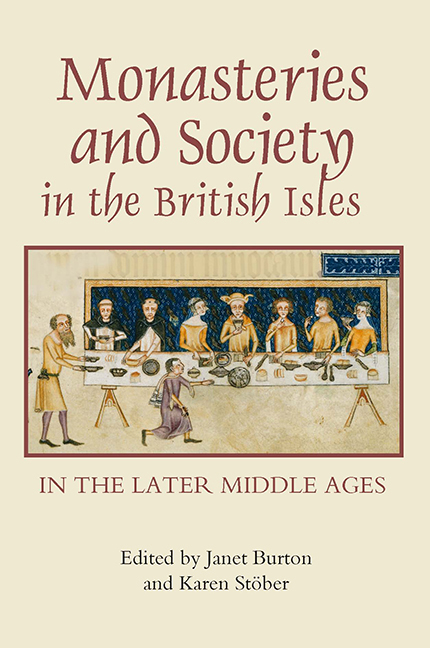Book contents
- Frontmatter
- Contents
- List of illustrations
- Acknowledgements
- List of contributors
- Abbreviations
- Introduction
- The Meeting of the Worlds
- Religious Houses and their Patrons and Benefactors
- 5 Patronage, prestige and politics: The Observant Franciscans at Adare
- 6 The Augustinian priory of Wombridge and its benefactors in the later Middle Ages
- 7 The rising price of piety in the later Middle Ages
- Female Communities: Nuns, Abbesses and Prioresses
- Monasteries and Education
- Monasteries and Urban Space
- Religious Houses in the Regions
- Index of Religious Houses mentioned in the text
- Index
- Miscellaneous Endmatter
7 - The rising price of piety in the later Middle Ages
from Religious Houses and their Patrons and Benefactors
Published online by Cambridge University Press: 24 October 2017
- Frontmatter
- Contents
- List of illustrations
- Acknowledgements
- List of contributors
- Abbreviations
- Introduction
- The Meeting of the Worlds
- Religious Houses and their Patrons and Benefactors
- 5 Patronage, prestige and politics: The Observant Franciscans at Adare
- 6 The Augustinian priory of Wombridge and its benefactors in the later Middle Ages
- 7 The rising price of piety in the later Middle Ages
- Female Communities: Nuns, Abbesses and Prioresses
- Monasteries and Education
- Monasteries and Urban Space
- Religious Houses in the Regions
- Index of Religious Houses mentioned in the text
- Index
- Miscellaneous Endmatter
Summary
It was a universal belief in late medieval England that religious benefits could be bought. From well before the adoption of the official doctrine of purgatory in 1215 it was thought that the sufferings of the dead could be relieved by prayers and other good works, which could even be performed after death and financed on instalments from endowments. Witness the thousand or so religious houses, another thousand hospitals, numerous preceptories and colleges, and several thousand chantries that were endowed over nine centuries. Many of these institutions endured until the Reformation, until the Dissolution of the Monasteries of 1536–40, or, if secular colleges, chantries, or hospitals, for a further decade. Together they expressed the religious aspirations, fashions, and generosity of almost a thousand years of Christian benefactors. Few generations apparently contented themselves with what they had inherited. The first twenty great Benedictine abbeys had been endowed principally by Anglo- Saxon royalty with swathes of territory. Such truly regal beneficence ceased to be feasible by the Norman Conquest, yet many new religious houses were founded. Some still were the work of kings and queens, but many more were created by earls and lesser aristocrats, generally on a smaller scale, almost all for dozens of inmates or fewer, often indeed endowed with wastelands and advowsons that were of little economic value to the donors. Even at the Dissolution a handful of religious houses still had founders amongst the country gentry, for example the Husseys of Harting in the case of the Premonstratensian Abbey of Durnford (Sussex), and in that of the Augustinian priory of Church Gresley, the Gresleys of Drakelow (Derbyshire). Many more obscure people feature in the cartularies as contributors to the priories, preceptories, and cells that others had established. The thirteenth century witnessed the foundation of more modestly endowed chantries for single priests, both secular and monastic. Between 1310 and 1340 religiously competitive burghers of the provincial city of York founded forty chantries in their parish churches and the chapel on Ouse Bridge. Two centuries later wills and churchwardens’ accounts everywhere reveal mere parishioners commonly subscribing to the gilds, building projects and furnishings of their parishes, both in life and through bequests. Pre-Reformation Catholics continued to support such projects as long as they were permitted to do so: until the observances and their underlying doctrines, purgatory and the cult of saints, were suppressed and/or abolished.
- Type
- Chapter
- Information
- Publisher: Boydell & BrewerPrint publication year: 2008



